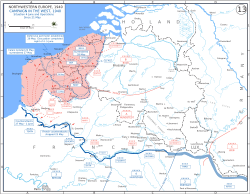Siege of Lille (1940) facts for kids
The Siege of Lille (May 28–31, 1940) was an important event during the Battle of France in World War II. It happened around the city of Lille in France. French soldiers from the First Army were surrounded by German forces. About 40,000 French troops faced much larger German forces, including many tanks.
Even though they were surrounded, the French soldiers fought bravely for several days. Their strong defense helped many other Allied (French and British) troops escape to Dunkirk. This allowed them to be rescued in what was called Operation Dynamo.
Quick facts for kids Siege of Lille |
|||||||
|---|---|---|---|---|---|---|---|
| Part of the Battle of France in the Second World War | |||||||
 Situation, 21 May – 4 June 1940 |
|||||||
|
|||||||
| Belligerents | |||||||
| Commanders and leaders | |||||||
| Jean-Baptiste Molinié (POW) Alphonse Juin (POW) Gustave Mesny (POW) |
Alfred Wäger Erwin Rommel Joachim Lemelsen Max von Hartlieb-Walsporn Ludwig Ritter von Radlmeier Fritz Kühne (POW) |
||||||
| Strength | |||||||
|
Elements of 6 divisions
|
4 infantry divisions
|
||||||
| Casualties and losses | |||||||
|
|||||||
Contents
How the Siege Started
By May 27, 1940, German tanks, called panzers, were moving very quickly through France. They had already cut off many Allied forces. The German 7th Panzer Division, led by Erwin Rommel, rushed forward. It cut off the Allied troops who were in and around Lille.
Many French and British soldiers were trying to retreat. Some British and French units managed to get away. But a large group of French soldiers from the First Army found themselves trapped. The German 6th Army then surrounded the city of Lille.
The Siege of Lille
The French forces in Lille were led by General Jean-Baptiste Molinié. They got a lucky break when a French patrol captured a German general, Fritz Kühne. They found important documents with him. These papers showed exactly where the German troops were positioned around Lille.
General Molinié used this information to plan a breakout attempt for May 28. French soldiers tried to fight their way out of the city. They attempted to cross rivers and bridges to reach safety. However, the Germans had mined some bridges and fought back hard. The French soldiers were forced to retreat back into the city.
The fighting in Lille was very tough. French soldiers fought from house to house in the city's suburbs. German troops tried to sneak through their defenses. Many civilians were also stuck in the city, making things even harder.
As days passed, the French soldiers ran out of food and ammunition. On May 29, one French division had to surrender. Finally, on May 31, General Molinié and his officers decided to surrender. The fighting ended at midnight on May 31.
General Molinié, along with about 350 officers and 34,600 French soldiers, surrendered. The German commander, General Alfred Wäger, showed great respect for the French soldiers. He allowed them to march through the main square of Lille with their weapons. This was a special honor called "honours of war." The German troops stood at attention as the French marched past. This was a rare sign of respect for a defeated enemy.
What Happened After
The brave defense of Lille was very important for the Allies. It held up the German advance for several days. This delay gave more time for other Allied troops to escape to Dunkirk. The evacuation of Dunkirk, called Operation Dynamo, was already happening.
Famous leaders and historians have praised the defense of Lille:
- Winston Churchill, the British Prime Minister, called it a "splendid contribution." He said it allowed the British Expeditionary Force (BEF) to escape from Dunkirk.
- William L. Shirer, a historian, wrote that the "gallant" (brave) defense helped save at least 100,000 more troops.
The defenders of Lille were one of only two French garrisons to receive the "honours of war" from Germany in both World Wars. This shows how much respect their bravery earned. The Battle of Lille kept about seven German divisions busy. This was crucial during the Dunkirk evacuation.
French and German Forces
Here are some of the main groups of soldiers who fought in the Siege of Lille:
French Forces
- Commander: General Jean-Baptiste Molinié
- Groups of soldiers included:
- 1st Motorized Infantry Division
- 2nd North African Infantry Division
- 1st Moroccan Division
- 15th Infantry Division
- 5th North African Infantry Division
German Forces
- Commanders included: General Alfred Wäger, General Hermann Hoth, General Joachim von Kortzfleisch
- Groups of soldiers included:
- 4th Panzer Division (tanks)
- 5th Panzer Division (tanks)
- 7th Panzer Division (tanks)
- 253rd Infantry Division
- 7th Infantry Division
- 217th Infantry Division
- 267th Infantry Division
Images for kids
See also
- List of French military equipment of World War II
- List of German military equipment of World War II



